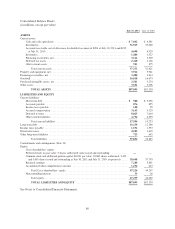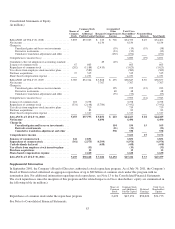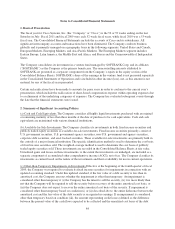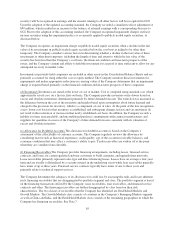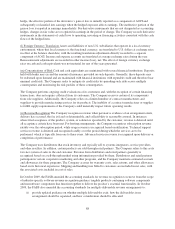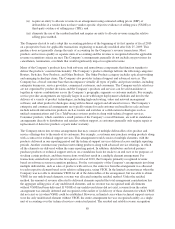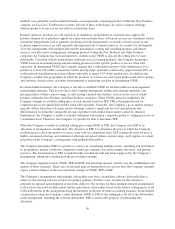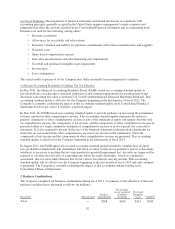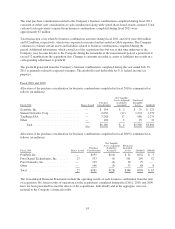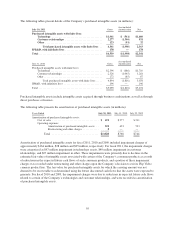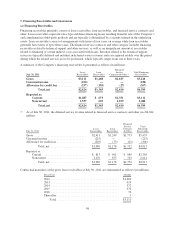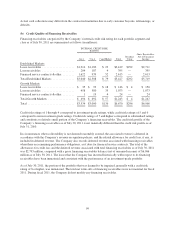Cisco 2011 Annual Report Download - page 98
Download and view the complete annual report
Please find page 98 of the 2011 Cisco annual report below. You can navigate through the pages in the report by either clicking on the pages listed below, or by using the keyword search tool below to find specific information within the annual report.methods were generally used in a limited number of arrangements containing products within the New Products
category, such as Cisco TelePresence systems. Several of these technologies are sold as solution offerings,
whereas products or services are not sold on a standalone basis.
In many instances, products are sold separately in standalone arrangements as customers may support the
products themselves or purchase support on a time-and-materials basis. Advanced services are sometimes sold in
standalone engagements such as general consulting, network management, or security advisory projects and
technical support services are sold separately through renewals of annual contracts. As a result, for substantially
all of the arrangements with multiple deliverables pertaining to routing and switching products and related
services, as well as most arrangements containing products within the New Products and Other Products
categories, the Company has used and intends to continue using VSOE to allocate the selling price to each
deliverable. Consistent with its methodology under previous accounting guidance, the Company determines
VSOE based on its normal pricing and discounting practices for the specific product or service when sold
separately. In determining VSOE, the Company requires that a substantial majority of the selling prices for a
product or service fall within a reasonably narrow pricing range, generally evidenced by approximately 80% of
such historical standalone transactions falling within plus or minus 15% of the median rates. In addition, the
Company considers the geographies in which the products or services are sold, major product and service groups
and customer classifications, and other environmental or marketing variables in determining VSOE.
In certain limited instances, the Company is not able to establish VSOE for all deliverables in an arrangement
with multiple elements. This may be due to the Company infrequently selling each element separately, not
pricing products within a narrow range, or only having a limited sales history, such as in the case of certain
products within the New Products and Other Products categories. When VSOE cannot be established, the
Company attempts to establish selling price of each element based on TPE. TPE is determined based on
competitor prices for similar deliverables when sold separately. Generally, the Company’s go-to-market strategy
typically differs from that of its peers and its offerings contain a significant level of customization and
differentiation such that the comparable pricing of products with similar functionality cannot be obtained.
Furthermore, the Company is unable to reliably determine what similar competitor products’ selling prices are on
a standalone basis. Therefore, the Company is typically not able to determine TPE.
When the Company is unable to establish selling price using VSOE or TPE, the Company uses ESP in its
allocation of arrangement consideration. The objective of ESP is to determine the price at which the Company
would transact a sale if the product or service were sold on a standalone basis. ESP is generally used for new or
highly customized offerings and solutions or offerings not priced within a narrow range, and it applies to a small
proportion of the Company’s arrangements with multiple deliverables.
The Company determines ESP for a product or service by considering multiple factors, including, but not limited
to, geographies, market conditions, competitive landscape, internal costs, gross margin objectives, and pricing
practices. The determination of ESP is made through consultation with and formal approval by the Company’s
management, taking into consideration the go-to-market strategy.
The Company regularly reviews VSOE, TPE and ESP, and maintains internal controls over the establishment and
updates of these estimates. There were no material impacts during the fiscal year nor does the Company currently
expect a material impact in the near term from changes in VSOE, TPE or ESP.
The Company’s arrangements with multiple deliverables may have a standalone software deliverable that is
subject to the existing software revenue recognition guidance. In these cases, revenue for the software is
generally recognized upon shipment or electronic delivery. The revenue for these multiple-element arrangements
is allocated to the software deliverable and the nonsoftware deliverables based on the relative selling prices of all
of the deliverables in the arrangement using the hierarchy in the new revenue accounting guidance. In the limited
circumstances where the Company cannot determine VSOE or TPE of the selling price for all of the deliverables
in the arrangement, including the software deliverable, ESP is used for the purposes of performing this
allocation.
90


